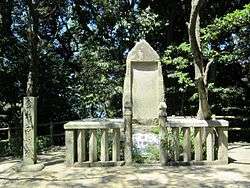Kanagasaki Castle
Kanegasaki Castle (金ヶ崎城, Kanegasaki-jō) was a Kamakura period yamashiro-style Japanese castle located in what is now part of the city of Tsuruga, Fukui Prefecture in the Hokuriku region of Honshu, Japan. It was also known as Tsuruga Castle. The site has been protected by the central government as a National Historic Site since 1934.[1]
| Kanegasaki Castle 金ヶ崎城 | |
|---|---|
| Tsuruga, Fukui Prefecture, Japan | |
 Kanegasaki Castle site | |
 Kanegasaki Castle 金ヶ崎城  Kanegasaki Castle 金ヶ崎城 | |
| Coordinates | 35°39′57.9″N 136°4′27″E |
| Type | yamashiro-style Japanese castle |
| Site information | |
| Open to the public | yes |
| Condition | ruins |
| Site history | |
| Built | Kamakura period |
| Built by | Taira no Michimori |
| In use | Kamakura to Sengoku periods |
| Demolished | unknown |
Background
Kanegasaki Castle is located on a small hill 86 meters above sea level, in the northeastern part of the city of Tsuruga. A fortification was first constructed here by Taira no Michimori (1153-1184) while fighting against Kiso Yoshinaka in the Genpei War. All that remains at present are the remnants of stone and earthen enclosures, moats and the foundations of the central building and gate. A Shinto shrine, the Kanegasaki-gu was built near the base of the hill during the Meiji period
History
During the Siege of Kanegasaki, forces loyal to Nitta Yoshisada was trapped for three months at Kanegasaki Castle by Ashikaga Takauji. Nitta's ally Uryū Tamotsu was forced back to the Somayama Castle in March 1337, and Nitta Yoshisada joined him soon afterwards. A failed counter-attack from Somayama Castle failed to lift the siege against Kanegasaki,[2] whose defenders were reduced to eating horseflesh to survive, and almost resorted to cannibalism before surrendering. Nitta Yoshiaki, (the son of Nitta Yoshisada) Prince Takanaga, and some 300 partisans of the Southern Court were killed or committed suicide when the castle fell. [2]
Another battle was the Siege of Kanegasaki (1570) when the Oda Nobunaga led a failed attack against the forces of the Asakura clan. Toyotomi Hideyoshi, then known as “Kinoshita Hideyoshi” fought a celebrated rear-guard action by which Nobunaga was able to escape the defeat.
References
- "金ヶ崎城跡 かながさきじょうあと". Cultural Heritage Online (in Japanese). Agency for Cultural Affairs. Retrieved 25 December 2016.
- Sansom, George (1961). A History of Japan, 1334-1615. Stanford University Press. pp. 63–64. ISBN 978-0804705257.
External links
| Wikimedia Commons has media related to Kanegasaki Castle. |
- JCastle site
- Fukui prefecture official home page (in Japanese)